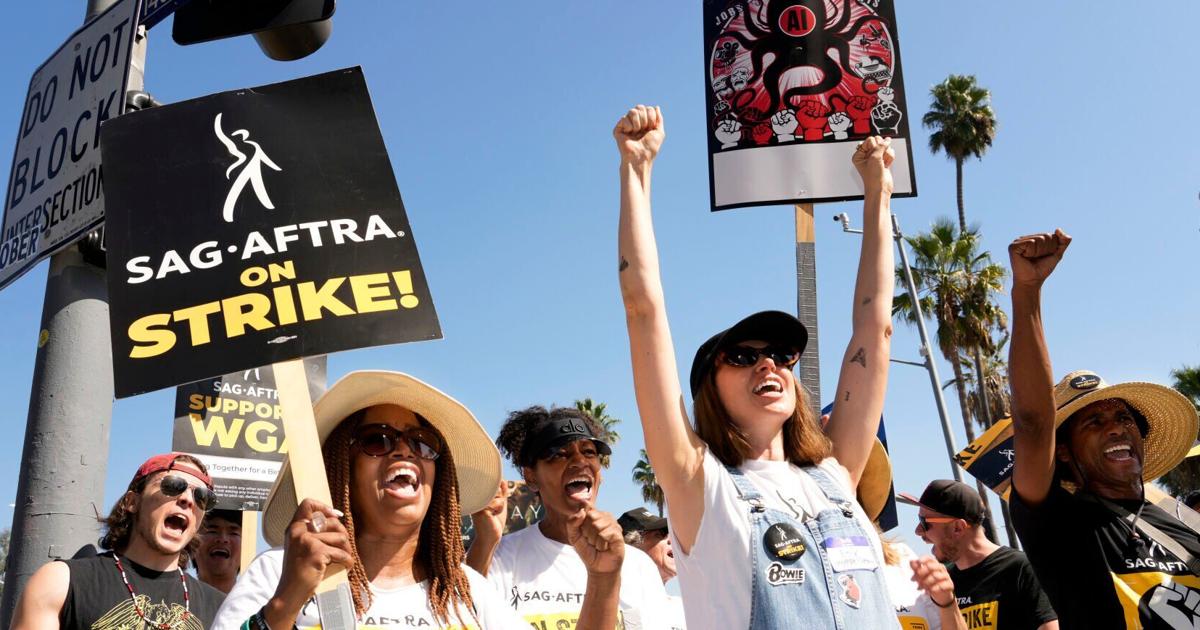LOS ANGELES — While screenwriters are busy back at work, film and TV actors remain on picket lines, with the longest strike in their history set to hit 100 days on Saturday after talks broke off with studios. Here’s a look at where things stand, how their stretched-out standoff compares to past strikes, and what happens next.
INSIDE THE ACTORS-STUDIO TALKS THAT FAILED
Hopes were high and leaders of the Screen Actors Guild-American Federation of Television and Radio Artists were cautiously optimistic when they resumed negotiations on Oct. 2 for the first time since the strike began 2 1/2 months earlier.
The same group of chief executives from the biggest studios had made a major deal just over a week earlier with striking writers, whose leaders celebrated their gains on many issues actors are also fighting for: long-term pay, consistency of employment and control over the use of artificial intelligence.
People are also reading…
But the actors’ talks were tepid, with days off between sessions and no reports of progress. Then studios abruptly ended them on Oct. 11, saying the actors’ demands were exorbitantly expensive and the two sides were too far apart to continue.
“We only met with them a couple of times, Monday, half a day Wednesday, half a day Friday. That was what they were available for,” SAG-AFTRA President Fran Drescher told The Associated Press soon after the talks broke off. “Then this past week, it was Monday and a half a day on Wednesday. And then “Bye bye. I’ve never really met people that actually don’t understand what negotiations mean. Why are you walking away from the table?”
The studios said the SAG-AFTRA proposals would cost them an untenable $800 million annually. The union said that number was a 60% overestimate.
Netflix co-CEO Ted Sarandos, one of the executives in on the bargaining sessions, said that at the session that spurred the studios to walk away, the union had asked for a “a subscriber levy unrelated to viewing or success” on every subscriber to streaming services.
“This really broke our momentum unfortunately,” Sarandos told investors on a Netflix earnings call Wednesday.
SAG-AFTRA leaders said it was ridiculous to frame this demand as as though it were a tax on customers, and said it was the executives themselves who wanted to shift from a model based on a show’s popularity to one based on number of subscribers.
“We made big moves in their direction that have just been ignored and not responded to,” Duncan Crabtree-Ireland, SAG-AFTRA’s national executive director and chief negotiator, told the AP. “We made changes to our AI proposal. We made dramatic changes to what used to be our streaming revenue share proposal,” Crabtree-Ireland said.
WHAT HAPPENS NEXT IN THE ACTORS STRIKE?
The actors are in unscripted territory, with no end in sight. Their union has never been on a strike this long, nor been on strike at all since before many of its members were born. Not even its veteran leaders, like Crabtree-Ireland, with the union for 20 years, have found themselves in quite these circumstances.
As they did for months before the talks broke off, members and leaders will rally, picket and speak out publicly until the studios signal a willingness to talk again. No one knows how long that will take. SAG-AFTRA says it is willing to resume at any time, but that won’t change its demands.
“I think that they think that we’re going to cower,” Drescher said. “But that’s never going to happen because this is a crossroads and we must stay on course.”
The studio alliance said in a statement after the talks broke off that they had made generous-but-rejected offers in every disputed area. “We hope that SAG-AFTRA will reconsider and return to productive negotiations soon,” the statement said.
The writers did have their own false start with studios that may give some reason for optimism. Their union attempted to restart negotiations with studios in mid-August, more than three months into their strike. Those talks went nowhere, breaking off after a few days. A month later, the studio alliance came calling again. Those talks took off, with most of their demands being met after five marathon days that resulted in a tentative deal that its members would vote to approve almost unanimously.
HOW DID PREVIOUS ACTORS STRIKES PLAY OUT?
Hollywood actors strikes have been less frequent and shorter than those by writers. The Screen Actors Guild (they added the “AFTRA” in a 2011 merger) has gone on strike against film and TV studios only three times in its history.
In each case, emerging technology fueled the dispute. In 1960 — the only previous time actors and writers struck simultaneously — the central issue was actors seeking pay for when their work in film was aired on television, compensation the industry calls residuals. The union, headed by future U.S. President Ronald Reagan, was a smaller and much less formal entity then. The vote to strike took place in the home of actors Tony Curtis and Janet Leigh, the parents of current SAG-AFTRA member and vocal striker Jamie Lee Curtis.
Mid-strike, the actors and studios called a truce so all could attend the Academy Awards — a move forbidden under today’s union rules. Host Bob Hope called the gathering “Hollywood’s most glamorous strike meeting.”
In the end, a compromise was reached where SAG dropped demands for residuals from past films in exchange for a donation to their pension fund, along with a formula for payment when future films aired on TV. Their 42-day work stoppage began and ended all within the span of the much longer writers strike.
A 1980 strike would be the actors’ longest for film and television until this year. That time, they were seeking payment for their work appearing on home video cassettes and cable TV, along with significant hikes in minimum compensation for roles. A tentative deal was reached with significant gains but major compromises in both areas. Union leadership declared the strike over after 67 days, but many members were unhappy and balked at returning to work. It was nearly a month before leaders could rally enough votes to ratify the deal.
This time, it was the Emmy Awards that fell in the middle of the strike. The Television Academy held a ceremony, but after a boycott was called, only one acting winner, Powers Boothe, was there to accept his trophy.
Other segments of the actors union have gone on strike too, including several long standoffs over the TV commercials contract. A 2016-2017 strike by the union’s video game voice actors lasted a whopping 11 months. That segment of the union could strike again soon if a new contract deal isn’t reached.
WHAT’S HAPPENING TO MOVIES AND TV SHOWS?
The return of writers has gotten the Hollywood production machine churning again, with rooms full of scribes penning new seasons of shows that had been suspended and film writers finishing scripts. But the finished product will await the end of actors strike, and production will remain suspended many TV shows and dozens of films, including “Wicked,” “Deadpool 3” and “Mission Impossible — Dead Reckoning Part 2.”
The Emmys, whose nominations were announced the same day the actors strike was called, opted to wait for the stars this time and move their ceremony from September to January, though that date could be threatened too.
The Oscars are a long way off in March, but the campaigns to win them are usually well underway by now. With some exceptions — non-studio productions approved by the union — performers are prohibited from promoting their films at press junkets or on red carpets. Director Martin Scorsese has been giving interviews about his new Oscar contender ” Killers of the Flower Moon.” Star and SAG-AFTRA member Leonardo DiCaprio hasn’t.
The Most Unionized Cities in America
The Most Unionized Cities in America

Photo Credit: Blue Planet Studio / Shutterstock
Labor unions in the United States have faced major challenges over the last several decades. Anti-union initiatives by employers, the growing prominence of the gig economy, and shifting labor laws, among other factors, all contributed to a steady decline in union membership. But recently, interest in unionization has resurfaced. The narrowly averted UPS strike and notable strikes by writers and actors in Hollywood have garnered major interest and made headlines nationwide. Desires for better compensation and working conditions have once again taken center stage.
Union members enjoy higher wages than non union workers

Union workers not only have more protection from unemployment, they also enjoy wage premiums over non-union workers. Data from the Bureau of Labor Statistics found that in 2022, the median wage for full-time union workers was $1,216 per week compared to only $1,029 per week for full-time non-union workers. In other words, union workers earn about 18% more than their non-union counterparts, which for the typical worker, is nearly $10,000 in additional compensation annually. A major reason for this wage disparity is union workers’ ability to benefit from the union’s collective bargaining power, rather than relying on individual negotiations with an employer.
Union membership in the US continues to decline

Although union members on average earn more than their non-union worker counterparts, union membership in the U.S. has declined significantly over the past several decades. This downward trend is in part due to more states passing so-called “right-to-work” laws, and changes in the composition of the U.S. labor force. In 1979, the union membership rate peaked at just over 24% of U.S. employees. By contrast, only 10.1% of American workers were union members in 2022. In nominal numbers, union membership accounted for roughly 14.3 million workers in 2022, approximately 6.7 million fewer than the 1979 peak.
Pacific and Northeastern states have the highest unionization rates

Although union membership rates are declining nationally, differences in local economies, politics, and legislation can impact union membership rates at the state level. Coastal states such as Hawaii, New York, and Washington have the highest membership rates, at 21.7%, 20.6%, and 18.0%, respectively. Conversely, Southern states—many of which have right-to-work legislation enacted—tend to have lower union membership rates. Southern states such as South Carolina (1.7%), North Carolina (2.8%), Virginia (3.7%), Texas (4.1%), Georgia (4.4%), and Florida (4.5%) all rank in the bottom 10 states for union membership.
To determine the most unionized locations in America, researchers at Construction Coverage, a website that provides construction software and insurance reviews, analyzed data from UnionStats.com and the U.S. Bureau of Labor Statistics. The researchers ranked metropolitan areas according to total union members as a percentage of total employment. In addition to union membership, the researchers also included statistics on union representation, which is the share of workers whose terms of work are collectively negotiated (whether or not they are union members).
Here are the most unionized U.S. metropolitan areas.
The most unionized small and midsize metros

15. Los Angeles-Long Beach-Anaheim, CA

Photo Credit: Sean Pavone / Shutterstock
- Union membership rate: 13.6%
- Union representation rate: 14.7%
- Workers who are members of unions: 736,464
- Workers who are represented by unions: 792,202
- Total employment: 5,399,876
14. Minneapolis-St. Paul-Bloomington, MN-WI

Photo Credit: Checubus / Shutterstock
- Union membership rate: 13.7%
- Union representation rate: 14.6%
- Workers who are members of unions: 270,873
- Workers who are represented by unions: 288,625
- Total employment: 1,982,212
13. San Francisco-Oakland-Berkeley, CA

Photo Credit: Bogdan Vacarciuc / Shutterstock
- Union membership rate: 13.7%
- Union representation rate: 14.3%
- Workers who are members of unions: 295,446
- Workers who are represented by unions: 307,971
- Total employment: 2,158,220
12. Fresno, CA

Photo Credit: Jacob Boomsma / Shutterstock
- Union membership rate: 14.2%
- Union representation rate: 17.4%
- Workers who are members of unions: 49,396
- Workers who are represented by unions: 60,762
- Total employment: 348,751
11. Philadelphia-Camden-Wilmington, PA-NJ-DE-MD

Photo Credit: Zack Frank / Shutterstock
- Union membership rate: 14.4%
- Union representation rate: 15.5%
- Workers who are members of unions: 406,200
- Workers who are represented by unions: 436,670
- Total employment: 2,815,535
10. Hartford-East Hartford-Middletown, CT

Photo Credit: Jon Bilous / Shutterstock
- Union membership rate: 14.5%
- Union representation rate: 16.0%
- Workers who are members of unions: 81,747
- Workers who are represented by unions: 90,086
- Total employment: 562,300
9. San Diego-Chula Vista-Carlsbad, CA

Photo Credit: Lucky-photographer / Shutterstock
- Union membership rate: 15.6%
- Union representation rate: 17.6%
- Workers who are members of unions: 218,491
- Workers who are represented by unions: 247,531
- Total employment: 1,402,461
8. Portland-Vancouver-Hillsboro, OR-WA

Photo Credit: Bob Pool / Shutterstock
- Union membership rate: 15.8%
- Union representation rate: 16.8%
- Workers who are members of unions: 180,926
- Workers who are represented by unions: 193,133
- Total employment: 1,147,550
7. Detroit-Warren-Dearborn, MI

Photo Credit: Ivan Cholakov / Shutterstock
- Union membership rate: 15.8%
- Union representation rate: 16.8%
- Workers who are members of unions: 306,407
- Workers who are represented by unions: 327,113
- Total employment: 1,943,364
6. Providence-Warwick, RI-MA

Photo Credit: Richard Cavalleri / Shutterstock
- Union membership rate: 16.2%
- Union representation rate: 18.0%
- Workers who are members of unions: 122,477
- Workers who are represented by unions: 136,074
- Total employment: 755,483
5. Seattle-Tacoma-Bellevue, WA

Photo Credit: ESB Professional / Shutterstock
- Union membership rate: 16.6%
- Union representation rate: 18.0%
- Workers who are members of unions: 325,707
- Workers who are represented by unions: 352,346
- Total employment: 1,960,848
4. Riverside-San Bernardino-Ontario, CA

Photo Credit: Matt Gush / Shutterstock
- Union membership rate: 17.8%
- Union representation rate: 22.2%
- Workers who are members of unions: 329,984
- Workers who are represented by unions: 411,934
- Total employment: 1,855,064
3. New York-Newark-Jersey City, NY-NJ-PA

Photo Credit: Ingus Kruklitis / Shutterstock
- Union membership rate: 18.1%
- Union representation rate: 19.5%
- Workers who are members of unions: 1,606,871
- Workers who are represented by unions: 1,722,399
- Total employment: 8,854,530
2. Sacramento-Roseville-Folsom, CA

Photo Credit: Sundry Photography / Shutterstock
- Union membership rate: 19.7%
- Union representation rate: 21.8%
- Workers who are members of unions: 190,653
- Workers who are represented by unions: 211,139
- Total employment: 968,122
1. Buffalo-Cheektowaga, NY

Photo Credit: Sergey Novikov / Shutterstock
- Union membership rate: 23.5%
- Union representation rate: 25.8%
- Workers who are members of unions: 108,420
- Workers who are represented by unions: 119,015
- Total employment: 460,560











